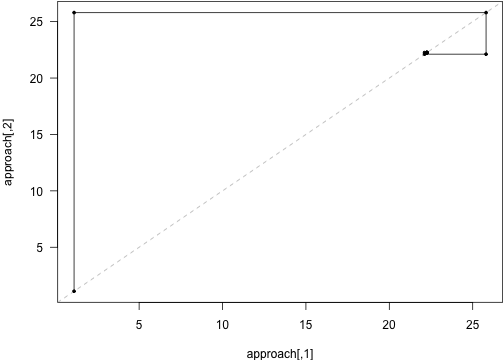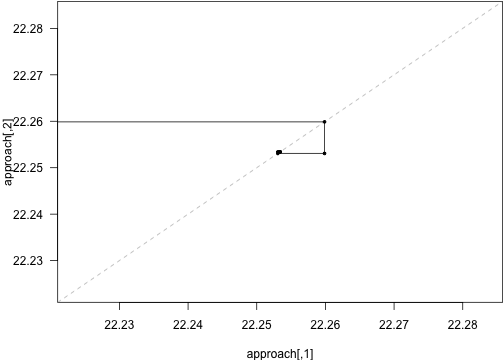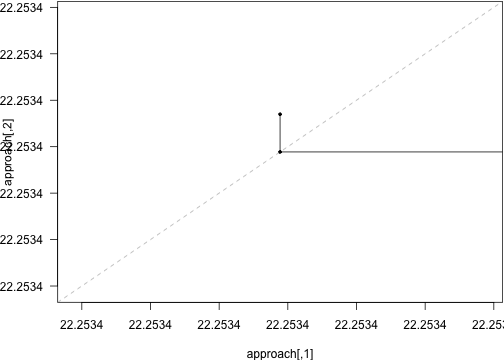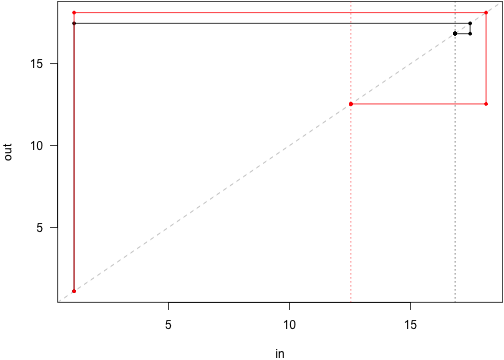-
Notifications
You must be signed in to change notification settings - Fork 20
equilibrium
library(tree)library(parallel)run <- function(seed_rain_in, p, schedule) {
p$seed_rain <- seed_rain_in
run_ebt(p, schedule)$seed_rains
}run_new_schedule <- function(w, p, schedule=NULL) {
p$seed_rain <- w
res <- build_schedule(p, schedule)
unname(attr(res, "seed_rain")[,"out"])
}Try to establish what the equilubrium seed rain is.
p <- ebt_base_parameters()p$add_strategy(new(Strategy, list(lma=0.08)))p$seed_rain <- 1.1res <- equilibrium_seed_rain(p)## 1: Splitting {27} times (141)
## 2: Splitting {10} times (168)
## *** 1: {1.1} -> {25.8} (delta = {24.7})
## 1: Splitting {37} times (141)
## 2: Splitting {21} times (178)
## 3: Splitting {12} times (199)
## 4: Splitting {8} times (211)
## *** 2: {25.8} -> {22.11} (delta = {-3.69})
## 1: Splitting {1} times (219)
## *** 3: {22.11} -> {22.26} (delta = {0.1473})
## *** 4: {22.26} -> {22.25} (delta = {-0.006802})
## *** 5: {22.25} -> {22.25} (delta = {0.0003452})
## *** 6: {22.25} -> {22.25} (delta = {-1.673e-05})
## *** 7: {22.25} -> {22.25} (delta = {8.111e-07})
## Reached target accuracy (delta 8.11121e-07 < 1.00000e-05 eps)
seed_rain_eq <- unname(res[["seed_rain"]][,"in"])schedule1 <- res[["schedule"]]$copy()Sanity and time check
system.time(delta <- run(seed_rain_eq, p, schedule1) -
unname(res[["seed_rain"]][,"out"]))## user system elapsed
## 4.644 0.014 4.782
delta## [1] 0
Plot the approach:
approach <- t(sapply(attr(res, "progress"), "[[", "seed_rain"))From a distance, these both hone in nicely on the equilibrium, and rapidly, too.
r <- range(approach)plot(approach, type="n", las=1, xlim=r, ylim=r)abline(0, 1, lty=2, col="grey")cobweb(approach, pch=19, cex=.5, type="o")
Zoom in on the last few points:
r <- seed_rain_eq + c(-1, 1) * 0.03plot(approach, type="n", las=1, xlim=r, ylim=r)abline(0, 1, lty=2, col="grey")cobweb(approach, pch=19, cex=.5, type="o")
Zoom in on the last few points to see where the insability kicks in:
r <- seed_rain_eq + c(-1, 1) * 0.000003plot(approach, type="n", las=1, xlim=r, ylim=r)abline(0, 1, lty=2, col="grey")cobweb(approach, pch=19, cex=.5, type="o")
Then, in the vinicity of the root we should look at what the curve actually looks like, without adaptive refinement.
dr <- 2 # range of input to vary (plus and minus this many seeds)seed_rain_in <- seq(seed_rain_eq - dr,
seed_rain_eq + dr, length=31)seed_rain_out <- unlist(mclapply(seed_rain_in, run, p, schedule1))fit <- lm(seed_rain_out ~ seed_rain_in)Here is input seeds vs output seeds:
plot(seed_rain_in, seed_rain_out, xlab="Incoming seed rain",
ylab="Outgoing seed rain", las=1)abline(0, 1, lty=2, col="grey")abline(fit, lty=2)cobweb(approach)
See instability.R for more exploration of this:
plot(seed_rain_in, resid(fit),
xlab="Incoming seed rain", ylab="Residual seed rain",
las=1, pch=1)abline(h=0, v=seed_rain_eq)
seed_rain_in_global <- seq(1, max(approach), length.out=51)This takes quite a while to compute.
seed_rain_out_global <-
unlist(mclapply(seed_rain_in_global, run_new_schedule, p))This is pretty patchy, which is due to incompletely refining the
cohort schedule, I believe. Tighten schedule_eps to make the
curve smoother, at the cost of potentially a lot more effort.
plot(seed_rain_in_global, seed_rain_out_global,
las=1, type="l",
xlab="Incoming seed rain", ylab="Outgoing seed rain")abline(0, 1, lty=2, col="grey")abline(fit, lty=2)cobweb(approach, lty=3)
p <- ebt_base_parameters()p$add_strategy(new(Strategy, list(lma=0.08)))p$add_strategy(new(Strategy, list(lma=0.15)))p$seed_rain <- c(1.1, 1.1) # Starting rain.res <- equilibrium_seed_rain(p)## 1: Splitting {10,22} times (141,141)
## 2: Splitting {0,9} times (151,163)
## 3: Splitting {0,3} times (151,172)
## *** 1: {1.1,1.1} -> {17.46,18.12} (delta = {16.36,17.02})
## 1: Splitting {19,25} times (141,141)
## 2: Splitting {5,27} times (160,166)
## 3: Splitting {0,12} times (165,193)
## 4: Splitting {0,3} times (165,205)
## *** 2: {17.46,18.12} -> {16.83,12.54} (delta = {-0.6296,-5.578})
## *** 3: {16.83,12.54} -> {16.84,12.53} (delta = {0.01047,-0.008564})
## *** 4: {16.84,12.53} -> {16.84,12.53} (delta = {-0.0003415,-0.0003512})
## *** 5: {16.84,12.53} -> {16.84,12.53} (delta = {9.71e-06,1.234e-05})
## *** 6: {16.84,12.53} -> {16.84,12.53} (delta = {-2.769e-07,-3.537e-07})
## Reached target accuracy (delta 3.53698e-07 < 1.00000e-05 eps)
seed_rain_eq <- res[["seed_rain"]][,"out"]progress_seed_rain <- lapply(attr(res, "progress"), "[[", "seed_rain")approach <- lapply(seq_len(p$size), function(i)
t(sapply(progress_seed_rain, function(x) x[i,])))From a distance, these both hone in nicely on the equilibrium, and rapidly, too.
r <- range(unlist(approach))plot(approach[[1]], type="n", las=1, xlim=r, ylim=r)abline(0, 1, lty=2, col="grey")cols <- c("black", "red")for (i in seq_along(approach)) {
cobweb(approach[[i]], pch=19, cex=.5, type="o", col=cols[[i]])
}abline(v=seed_rain_eq, col=1:2, lty=3)